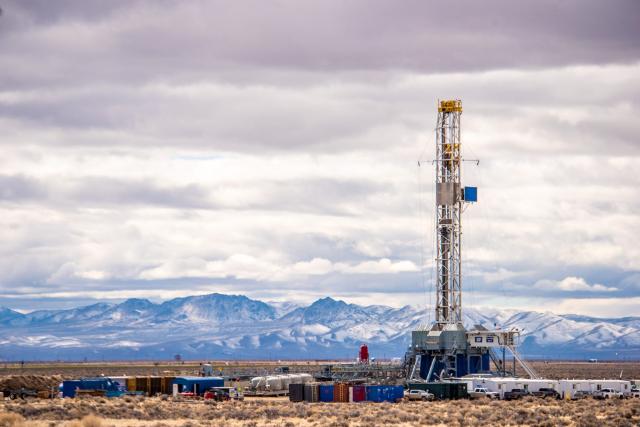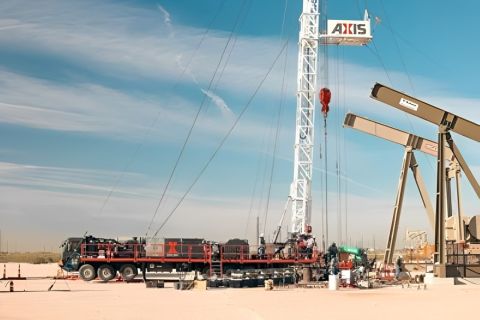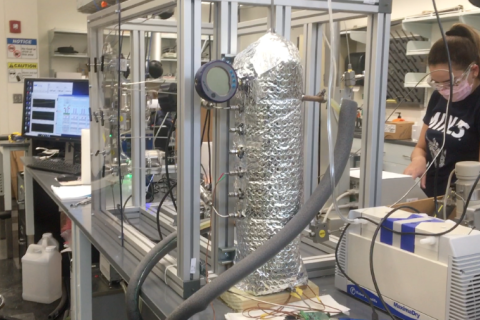
Fervo Energy says well test results confirm record production of enhanced geothermal energy. (Source: Fervo Energy)
Using oil and gas horizontal drilling techniques to help capture geothermal energy, startup Fervo Energy said July 18 it has proven the commercial viability of its drilling technology, marking a breakthrough that could strengthen geothermal’s prowess as a carbon-free energy source.
Called Project Red, Fervo’s full-scale commercial pilot in northern Nevada involved drilling a first-of-its-kind enhanced geothermal system (EGS) horizontal double-well system with an injection and production well pair into a high-temperature, hard rock geothermal formation.
During the 30-day well test, the Houston-based company said it used a multistage, plug-and-perforate stimulation treatment design with proppant to improve permeability of both horizontal wells. Lateral sections reached about 3,250 ft with temperatures up to 376 F. The result was an EGS record-setting flow rate of 63 liters per second that made way for a record EGS output of 3.5 megawatts (MW) of produced electricity, the company said.
“By applying drilling technology from the oil and gas industry, we have proven that we can produce 24/7 carbon-free energy resources in new geographies across the world,” Fervo CEO Tim Latimer said in a news release.
Geothermal energy taps into heat belowground by drilling wells into reservoirs. Unlike conventional geothermal, where cold water is pumped into hot reservoirs via vertical injection wells, heated to hot water or steam and then returned to the surface via production wells, EGS incorporates additional technologies. These include hydraulic and chemical stimulation—similar to shale drilling—to improve the permeability of hot dry rock. Fervo uses modern Organic Rankine Cycle generating technology to convert geothermal energy into electricity.
“In our new way of doing next generation geothermal, you don’t do the simple vertical wells anymore. You drill deep wells and then you drill horizontally for thousands of feet, much like they did in the oil and gas industry,” Latimer said in June at the EEI 2023 conference. “You create injection and production wells through tightly controlled multi-stage fractures that can sweep across that entire horizontal reservoir. “
‘No technical barriers’
The pilot is seen as a win for an industry that had been plagued by dry holes and a need for technology improvements.
Fervo Energy—a portfolio company of Bill Gates-backed Breakthrough Energy with Devon Energy and SLB among its partners—is also guided by real-time data on flow, temperature and performance gathered from fiber optic cables downhole. Its wells are typically drilled to vertical depths of approximately 8,000 ft and approximately 4,000 ft horizontally.
“In contrast to the dry hole and uncertainty that has been a big part of geothermal today, we actually for the first time know exactly where the fluid flow is going and can target wells very precisely to ensure that we don’t ever have a dry hole again,” Latimer said.
Results also validated the stimulation treatment design yielded flow across the entire lateral length with “no significant thermal short-circuit pathways” created during stimulation, according to a report on the commercial-scale demonstration project.
Fervo sees “no major technical barriers” to deploying horizontal EGS systems in formations similar to that of its pilot in Nevada. Simulation models with field data from the project show power capacity could reach up to 8 MW per production well, the company said in a report.
“Data collected through the course of this pilot will enable rapid advancement in geothermal deployment, with Fervo’s next horizontal well pair planned to achieve more than double the power output of the pilot design,” the company said in the news release.
Speaking to Hart Energy earlier this year, Fervo CTO Jack Norbeck said no one had drilled a horizontal geothermal well before Fervo.
“We’re able to leverage all of the innovations that have occurred already in unconventional oil and gas and apply those today. We were fortunate to be able to build upon over a decade of innovation from oil and gas and use that as our starting point for geothermal,” Norbeck said.
While there are several similarities between oil and geothermal drilling, there are also some key differences. The biggest one is the need to drill pairs of injection and production wells to efficiently extract geothermal resources, he said, noting that requires communication between the two in the subsurface.
“We actually aim to achieve connectivity through the stimulation process between wells. In other words, we try to encourage frac hits,” Norbeck said. “And because we have that slightly different objective, some of the tools and diagnostic methods that are standard in oil and gas, they can still be applied in geothermal, but you have to take a slightly different approach.”
Looking ahead
Fervo’s drilling and well test results could help move the U.S. closer to supplying 60 gigawatts of EGS and hydrothermal resources to the grid by 2050 and decarbonizing buildings’ heating and cooling loads by installing geothermal heat pumps in 28 million households by 2050.
The company has already teamed up with Google, having signed a corporate agreement in 2021 to power the tech giant’s Google Cloud region in Las Vegas.
“Achieving our goal of operating on 24/7 carbon-free energy will require new sources of firm, clean power to complement variable renewables like wind and solar,” Michael Terrell, senior director for energy and climate for Google, said in the news release. “We partnered with Fervo in 2021 because we see significant potential for their geothermal technology to unlock a critical source of 24/7 carbon-free energy at scale, and we are thrilled to see Fervo reach this important technical milestone.”
Fervo is currently developing its first greenfield project in southwest Utah. The 90-MW project is adjacent to the U.S. Department of Energy’s Frontier Observatory for Research in Geothermal Energy. The company said it plans to bring the first phase of the project online by 2026, providing geothermal power to Southern California power buyers.
Recommended Reading
Geothermal ‘Could Save the World,’ but Faces Familiar Subsurface Risks
2024-03-20 - CERAWeek panelists discussed hurdles to widespread use of Earth’s heat to generate power — problems familiar to oil and gas operators.
Defeating the ‘Four Horsemen’ of Flow Assurance
2024-04-18 - Service companies combine processes and techniques to mitigate the impact of paraffin, asphaltenes, hydrates and scale on production—and keep the cash flowing.
Tech Trends: AI Increasing Data Center Demand for Energy
2024-04-16 - In this month’s Tech Trends, new technologies equipped with artificial intelligence take the forefront, as they assist with safety and seismic fault detection. Also, independent contractor Stena Drilling begins upgrades for their Evolution drillship.
Axis Energy Deploys Fully Electric Well Service Rig
2024-03-13 - Axis Energy Services’ EPIC RIG has the ability to run on grid power for reduced emissions and increased fuel flexibility.
Going with the Flow: Universities, Operators Team on Flow Assurance Research
2024-03-05 - From Icy Waterfloods to Gas Lift Slugs, operators and researchers at Texas Tech University and the Colorado School of Mines are finding ways to optimize flow assurance, reduce costs and improve wells.






